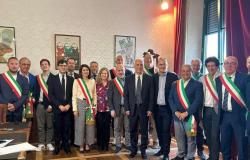The dawn of a new energy era illuminated Milan on Thursday 30 May, when industry leaders gathered at the Sustainable Future Energy Summit, an event promoted by Class Cnbc. During the meeting, a debate opened that promises to redefine Italy’s energy future. Not just a simple summit, but a collision of ideas, ambitions and visions for a greener and more sustainable tomorrow. The Sustainable Future Energy Summit 2024 served to outline a detailed overview of the challenges and opportunities of the energy transition in Italy.
The partecipation of international experts and representatives of institutions helped to take stock of the situation on the international climate objectives to be achieved to guarantee a sustainable and competitive energy future for the country. The day was opened by the words of the Minister of the Environment and Energy Security, Gilberto Pichetto Fratin: «The Italian government has taken a very challenging decision», declared Pichetto, referring to the cut of 2 billion in subsidies harmful to the environment by 2025. He then underlined the importance of “a decisive approach to accelerate the energy transition and reduce the country’s environmental impact”.
Among the interventions of the players in the sector there was that of Francesco La Camera, general director of Irena: «There is rapid progress in the deployment of renewables; last year we installed 87% of capacity from renewable sources. The problem is that the speed is not in line with achieving the Paris objectives,” La Camera said. «So the question to be addressed is how to accelerate this path», he concluded, also underlining the growing demand for energy in Africa and South-East Asia.
Nicola Monti, CEO of Edison, illustrated the company’s investment plan, which includes 5 billion euros for production and investments in hydroelectric storage. «Storing with hydroelectric power instead of batteries creates an impact on the territory because we are talking about infrastructures that have local implications» explained Monti, who then explained the double economic and environmental advantage of such investments.
Enrico Giovannini, scientific director of Asvis, sees the need to address the problem of the cultural and political challenges of the energy transition: «The thing that worries me is that comparing the electoral manifestos of the different political forces, those of the center-right say that we must not repeat the Next Generation Eu experience while the centre-left forces say the opposite”, observed Giovannini. «This is the discriminating element: we all agree that we need to invest in research and development but we don’t agree on how to do it», he said, noting the political difficulties in managing funds and development strategies.
Also Renato Mazzoncini, CEO of the utility A2a, spoke about the need to finance innovation to achieve decarbonization goals. «The company accounts are doing very well, they are guided by an investment strategy started in 2021 which has produced a doubling of the company’s EBITDA, so we are happy. The theme of innovation is central, we do not yet have all the elements we need to decarbonise by 2050″ underlines Mazzoncini, however. «To have innovation you need someone who finances innovation. We have launched the largest Italian fund on the energy transition dedicated to startups precisely because we believe that they will provide us with all the tools we need”, he concluded. For Massimo Catizone, global head of ESG advisory at Unicredit, there is a need to think about transition plans that are credible: «Transition plans are strategic issues, which have direct repercussions on the bankability of a company. A consensus has been created around what the building blocks of a solid and credible transition plan should be. To be considered credible, a transition plan should be based on three pillars: the first is the environmental aspect, the second is the issue of capex and the third concerns sustainability governance”, these are the fundamental things according to Catizone. «The first theme, the environmental one, translates for a company into adopting ambitious targets verified by an external and qualified entity. The second aspect is the company’s demonstration to the market that it has the financial resources necessary to achieve the declared emission reduction. Finally, the governance aspect concerns the entire system of mechanisms, controls and skills that the company has equipped itself with to complete its transition plan”, he concluded.
Stefano Venier, CEO of Snam, noted progress in the regasification projects: «Work on the Ravenna regasification plant is progressing rapidly. We have reached 80% of the works on land and 35-40% of the works at sea. Everything is proceeding on time and in the direction of supply diversification.” Even for the Piombino regasification terminal, Venier assured that the infrastructure «is working with excellent continuity. As regards its transfer off the coast of Savona, we are on the path of the Path (Environmental Impact assessment, ed). We are speaking with the Ministry of the Environment and Energy Security to provide all the information necessary for the Via process.”
«The energy transition is moving forward rapidly with different levels of speed in different places in the world. There are different degrees of sensitivity and there have also been factors that have slowed it down, however the transition market remains in strong growth. We do not see any type of slowdown and we do not believe that it is possible for anyone to take a different position”, said Stefano Battaini, CEO of Prysmian, who discussed the growth of the energy transition market: “The pipeline of projects that they see to 2030 and 2032-33 is solid, exists and continues to remain a strong driver of growth. Let’s not forget that the transition does involve investing in renewables, but also in strengthening the grid. And this is a source of further investments from our customers.”
Luca Dal Fabbro, president of Iren, shifts attention to the opportunities in recycling materials: «It is objectively impossible to stop the supply chain from China in the short term, but on the recycling front in Italy we will be able to do a lot. We export 90% of all WEEE abroad, which is why Iren has invested in a business line in Italy for the recovery of these materials”. He explained: «Italy is not dependent on the 34 rare materials; we are dependent as an industrial system on 5/6 materials. If Iren manages to become the Italian leader in the sector, we will be able to give the Italian system a competitive advantage.”
In Italy «we must create productive ecosystems where the public and private sectors work together. Critical materials are not theoretically useful, but they move important systems: they are the basis of our defense, our electromedical equipment, batteries and much more. If we bring together public and private capital, we can create a critical mass, otherwise it will be impossible to counteract supplies from China and the United States.” (All rights reserved)
Milano Finanza – Issue 108 pag. 37 of 01/06/2024





